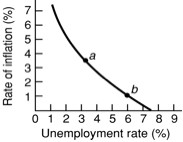 |
| 1 |  | 
If the economy is initially at a point on its long-run aggregate supply curve, a decrease in aggregate demand will: |
|  | A) | permanently increase unemployment |
|  | B) | temporarily increase unemployment |
|  | C) | permanently increase inflation |
|  | D) | temporarily increase inflation |
|
|
 |
| 2 |  | 
Because nominal wages do not fully adjust to price level changes in the short run: |
|  | A) | the short-run aggregate supply curve is vertical |
|  | B) | the short-run aggregate demand curve is downward sloping |
|  | C) | the short-run aggregate supply curve is upward sloping |
|  | D) | the long-run aggregate demand curve is horizontal |
|
|
 |
| 3 |  | 
In a hypothetical economy, suppose that from 2004 to 2006 the annual rate of inflation decreased from 8% to 6% to 4%. This economy is experiencing: |
|  | A) | stagflation |
|  | B) | disinflation |
|  | C) | deflation |
|  | D) | accelerating deflation |
|
|
 |
| 4 |  | 
An adverse supply shock will: |
|  | A) | move the economy upward and to the left along a fixed Phillips curve |
|  | B) | move the economy downward and to the right along a fixed Phillips curve |
|  | C) | reduce the misery index |
|  | D) | increase both the rate of inflation and the unemployment rate |
|
|
 |
| 5 |  | 
In the long run: |
|  | A) | both the aggregate supply curve and the Phillips curve are vertical |
|  | B) | the aggregate supply curve is vertical and the Phillips curve is horizontal |
|  | C) | government can permanently reduce the unemployment rate below its natural level |
|  | D) | government can permanently reduce the inflation rate below its natural level |
|
|
 |
| 6 |  | 
Use the following diagram to answer the next question.
 <a onClick="window.open('/olcweb/cgi/pluginpop.cgi?it=jpg::::/sites/dl/free/0073273082/384258/quiz15b_6.jpg','popWin', 'width=NaN,height=NaN,resizable,scrollbars');" href="#"><img valign="absmiddle" height="16" width="16" border="0" src="/olcweb/styles/shared/linkicons/image.gif"> (7.0K)</a> <a onClick="window.open('/olcweb/cgi/pluginpop.cgi?it=jpg::::/sites/dl/free/0073273082/384258/quiz15b_6.jpg','popWin', 'width=NaN,height=NaN,resizable,scrollbars');" href="#"><img valign="absmiddle" height="16" width="16" border="0" src="/olcweb/styles/shared/linkicons/image.gif"> (7.0K)</a>
Refer to the diagram. Assume the economy is initially at point a. A movement to point b might be caused by: |
|  | A) | a decrease in aggregate supply |
|  | B) | an increase in aggregate supply |
|  | C) | a decrease in aggregate demand |
|  | D) | an increase in aggregate demand |
|
|
 |
| 7 |  | 
Use the following diagram to answer the next question.
 <a onClick="window.open('/olcweb/cgi/pluginpop.cgi?it=jpg::::/sites/dl/free/0073273082/384258/quiz15b_7.jpg','popWin', 'width=NaN,height=NaN,resizable,scrollbars');" href="#"><img valign="absmiddle" height="16" width="16" border="0" src="/olcweb/styles/shared/linkicons/image.gif"> (7.0K)</a> <a onClick="window.open('/olcweb/cgi/pluginpop.cgi?it=jpg::::/sites/dl/free/0073273082/384258/quiz15b_7.jpg','popWin', 'width=NaN,height=NaN,resizable,scrollbars');" href="#"><img valign="absmiddle" height="16" width="16" border="0" src="/olcweb/styles/shared/linkicons/image.gif"> (7.0K)</a>
Refer to the diagram. Suppose the economy is initially at point b, where unemployment is at its natural rate of 6%. If the government institutes an expansionary monetary policy: |
|  | A) | the curve will immediately shift up and to the right, but will eventually return to this position |
|  | B) | the curve will immediately shift down and to the left, but will eventually return to this position |
|  | C) | the economy will move from point b towards point a and remain there |
|  | D) | the economy will move from point b towards point a, but unemployment will gradually increase |
|
|
 |
| 8 |  | 
In order to temporarily reduce the unemployment rate below its natural rate, the government could: |
|  | A) | decrease the rate of inflation below peoples' expectations |
|  | B) | reduce both the trade deficit and the budget deficit |
|  | C) | raise marginal tax rates and cut wasteful government spending |
|  | D) | increase the rate of inflation above peoples' expectations |
|
|
 |
| 9 |  | 
Use the following diagram to answer the next question.
 <a onClick="window.open('/olcweb/cgi/pluginpop.cgi?it=jpg::::/sites/dl/free/0073273082/384258/quiz15b_9.jpg','popWin', 'width=NaN,height=NaN,resizable,scrollbars');" href="#"><img valign="absmiddle" height="16" width="16" border="0" src="/olcweb/styles/shared/linkicons/image.gif"> (3.0K)</a> <a onClick="window.open('/olcweb/cgi/pluginpop.cgi?it=jpg::::/sites/dl/free/0073273082/384258/quiz15b_9.jpg','popWin', 'width=NaN,height=NaN,resizable,scrollbars');" href="#"><img valign="absmiddle" height="16" width="16" border="0" src="/olcweb/styles/shared/linkicons/image.gif"> (3.0K)</a>
Refer to the diagram. If the economy's tax rate is set at c, a decrease in the tax rate to b will: |
|  | A) | shift the curve to the right |
|  | B) | increase total tax revenue |
|  | C) | increase the size of the deficit |
|  | D) | shift the aggregate supply curve to the left |
|
|
 |
| 10 |  | 
Use the following diagram to answer the next question.
 <a onClick="window.open('/olcweb/cgi/pluginpop.cgi?it=jpg::::/sites/dl/free/0073273082/384258/quiz15b_10.jpg','popWin', 'width=NaN,height=NaN,resizable,scrollbars');" href="#"><img valign="absmiddle" height="16" width="16" border="0" src="/olcweb/styles/shared/linkicons/image.gif"> (10.0K)</a> <a onClick="window.open('/olcweb/cgi/pluginpop.cgi?it=jpg::::/sites/dl/free/0073273082/384258/quiz15b_10.jpg','popWin', 'width=NaN,height=NaN,resizable,scrollbars');" href="#"><img valign="absmiddle" height="16" width="16" border="0" src="/olcweb/styles/shared/linkicons/image.gif"> (10.0K)</a>
Refer to the diagram. Suppose the economy is initially at the full-employment output and price level represented by point d. Which of the following paths best represents the economy's response to an expansionary monetary policy? Point d to: |
|  | A) | point c to point b |
|  | B) | point b to point d |
|  | C) | point c to point a |
|  | D) | point c to point b to point a |
|
|

